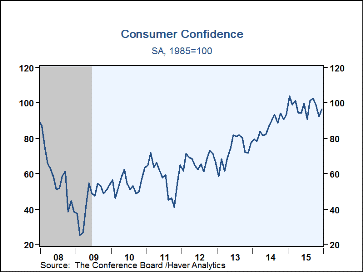 Global| Dec 29 2015
Global| Dec 29 2015U.S. Consumer Confidence Shows Partial Recovery
Summary
The Conference Board's Consumer Confidence Index rose 4.2% in December to 96.5 (1985=100) from November's revised 92.6 and up 3.7% from a year ago, but still lower than most other months this year. The December figure compared with a [...]
The Conference Board's Consumer Confidence Index rose 4.2% in December to 96.5 (1985=100) from November's revised 92.6 and up 3.7% from a year ago, but still lower than most other months this year. The December figure compared with a consensus expectation for 93.6, according to the Action Economics Forecast Survey. Readings for both the present situation and expectations shared in the December rise, with the present situation up 4.0% to 115.3 (+15.4% y/y), and expectations up 4.4% to 83.9 (-5.2% y/y).
The share of consumers believing business conditions are "good" rose to 27.3% in December from November's 25.0%, although the share believing conditions are "bad" also rose, from 16.9% to 19.8%. Thus, those thinking conditions are "normal" sank to 52.9%, the lowest since October 2012.
However, the assessment of the jobs market improved, as the number believing that jobs are "plentiful" rose to 24.1%, the second highest reading this year. September was 24.8%, and those two months mark the largest shares since late 2007, before the recession. The share of consumers thinking jobs are "hard to get" eased to 24.7% in December, close to the annual average for 2015 of 25.3%, compared to 30.6% in 2014.
The gain in expectations came about mainly because of a drop in the share of consumers looking for employment to fall; this share was 16.6% in December, down from 18.6% in November. Those expecting job opportunities to increase rose to 12.9% from 12.0%, making a positive move in the expected jobs "gap" from November's -6.5% to -3.7% in December. This is not absolutely favorable by any means, but clearly not as poor as November's more pessimistic jobs outlook.
Prospects for general business conditions deteriorated modestly, with those looking for improvement easing slightly and those looking conditions to deteriorate rose slightly, so that the "gap" in those readings decreased to +4.2% from +5.1%. People still believe that inflation is running close to 5%, with the December projection at 4.8%.
Buying plans included another slight decline in the percentage of respondents planning to buy a house, though at 5.8%, this share is a bit higher than the 2015 average 5.5%. Plans to buy major appliances increased to 51.5%, the second largest share this year after July's 52.1%. After a gain in November, plans to buy a car eased, to 10.5% from November's 12.7%; the average for the entire year is 11.9%.
The rebound in December's overall confidence reading was nearly all concentrated in younger consumers, age under 35. Among these people, confidence rose 18.8% to 126.0 (26.8% y/y), their highest reading since January. Those aged 35 to 54 had basically unchanged confidence in December, up a mere 0.8% to 99.3 (-3.2% y/y), and confidence edged lower among older consumers, down 1.0% to 77.7 and -7.2% y/y.
The Consumer Confidence data is available in Haver's CBDB database. The total indexes appear in USECON, and the market expectations are in AS1REPNA.
| Conference Board (SA, 1985=100) | Dec | Nov | Oct | Y/Y % | 2015 | 2014 | 2013 |
|---|---|---|---|---|---|---|---|
| Consumer Confidence Index | 96.5 | 92.6 | 99.1 | 3.7 | 98.0 | 86.9 | 73.2 |
| Present Situation | 115.3 | 110.9 | 114.6 | 15.4 | 111.6 | 87.4 | 67.6 |
| Expectations | 83.9 | 80.4 | 88.7 | -5.2 | 88.9 | 86.6 | 77.0 |
| Consumer Confidence By Age Group | |||||||
| Under 35 Years | 126.0 | 106.1 | 115.0 | 26.8 | 116.5 | 106.6 | 93.1 |
| Aged 35-54 Years | 99.3 | 98.5 | 110.1 | -3.2 | 103.8 | 92.4 | 76.8 |
| Over 55 Years | 77.7 | 78.5 | 82.3 | -7.2 | 84.0 | 73.8 | 61.2 |
Carol Stone, CBE
AuthorMore in Author Profile »Carol Stone, CBE came to Haver Analytics in 2003 following more than 35 years as a financial market economist at major Wall Street financial institutions, most especially Merrill Lynch and Nomura Securities. She had broad experience in analysis and forecasting of flow-of-funds accounts, the federal budget and Federal Reserve operations. At Nomura Securities, among other duties, she developed various indicator forecasting tools and edited a daily global publication produced in London and New York for readers in Tokyo. At Haver Analytics, Carol was a member of the Research Department, aiding database managers with research and documentation efforts, as well as posting commentary on select economic reports. In addition, she conducted Ways-of-the-World, a blog on economic issues for an Episcopal-Church-affiliated website, The Geranium Farm. During her career, Carol served as an officer of the Money Marketeers and the Downtown Economists Club. She had a PhD from NYU's Stern School of Business. She lived in Brooklyn, New York, and had a weekend home on Long Island.









